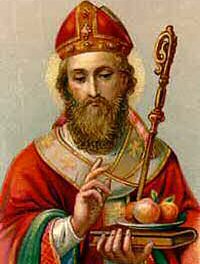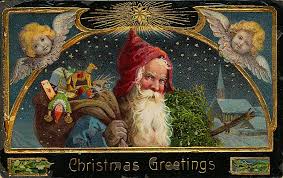
Something shot through the small window and hit the sleeping girl, waking her with a start. On the meager blanket lay a bag that had burst open and spilled coins over her arms--more than enough for the dowry that would allow her to marry the young man she adored."Mama! Look! I can marry now!"The girl's mother rose from her cot. "Let me see, child."The girl's young brother, more bone than boy, raced back through the doorway with a cloth bag. When he dropped it on the small table, it burst open and blocks of cheese, loaves of bread and a partridge fell out."And we can eat!" The boy dug through the food stuffs and lifted a small wooden soldier. "This is for me!"The mother came to the table, drawn as much by the fragrance as the hunger in her belly. "Yes, a toy for you," the mother whispered. "And, food until your father's ship returns."The girl drew the cloth from beneath the items. A smile slid across her lips. "And, Mama, you can use this as a shawl to keep you warm."The three gazed at each other, but only the little boy asked the question. "Who left these for us?"
On December 6, in the city of Myra in Turkey during the fourth century AD, a young man began tossing bags of money into the houses of girls who had no dowry so they could avoid ending up on the streets as prostitutes or sold into slavery. His name was Nicholas, the son of a wealthy family who continued seeing to the unfortunate until he too had no inheritance left. But his generosity was not forgotten or ignored. The church deemed him a bishop, and after his death he became know as St. Nicolas, patron saint of sailors and children. 
The tradition of gift giving of course had spread throughout history and the world. Romans, as we know, enjoyed giving gifts to one another and often shared with the poor. Yes they did.
By the 13th century, this generosity changed to giving to those less fortunate but without recognition, as St Nicholas and those who assisted him had done. By the time of the Reformation, Protestants changed the gift-giver to the Christ Child or Christkindle, later corrupted to Kris Kringle. However, in Holland, St. Nicholas became known as Sinter Klaas and then was corrupted to Santa Claus.
America was thriving by this time and the Dutch had brought this gift-giving tradition to New Amsterdam ( later known as New York City)

Over time St Nick had changed not only his name but his appearance. He was seen as a tall gaunt man or a spooky-looking elf, as a tall lean man wearing bishop robes or Norse huntsman wearing animal hide in colors from green, to white, to purple as well as red. With or without a beard.
Washington Irvin described Santa Claus as a jolly ol' gent in his short stories based on the Old English countryside tradition that he cherished. This was captured by a an artist, Thomas Nast, who also drew Santa as a small elflike figure who supported the Union during the Civil War. Nast continued to draw Santa for the next 30 years, changing the color of Santa's clothes from various colors including red.
In 1920 the Coca Cola company wanted a wholesome happy Santa for their ads and commissioned Haddon Sundblom to develop images they could use to sell their beverage in magazines as the Saturday Evening Post and the Lady's Home Journal. Sundblom used a live model to make his Santa... a friend and retired salesman named Lu Prentiss. When Prentiss passed away, Sundblom used himself by looking in a mirror. He also used neighborhood children or pet poodles for his artwork for Coca Cola.
By this time, Clement Clark Moore's poem 'A Visit from St Nicolas' had become extremely popular and had made St Nick into a warm friendly pleasantly plump Santa. We know this poem now as 'Twas the Night before Christmas"
In 1931, the world's largest soda fountain was in Famous Barr Co in St. Louis, MO, where one of Fred Mizen's first drawing of Santa enjoying a Coke was posted. I wish it was still there. From 1931 to 1964, Coca Cola signature color became red and thus Santa's signature color (and I would say it still is)
In 1942, Coca Cola introduced 'Sprite Boy' who appeared as a sprite or an elf with Santa. Together, from 1940-1950, these two gave out gifts and Cokes in Sundblom's ads. The beverage known as Sprite didn't appear until 1960's
.
Now we already know that elves help St Nick, St. Nicolas, Kris Kringle, Krista Klaas, or Santa Claus deliver his gifts.
But what about the chimney, reindeer and the North Pole? From Moore's poem, of course.
Or it is said that from Oden's flying horse with eight legs. And that fits because Oden was a model for Santa. He kinda does don't you think?
Thomas Nast drew Santa living at the North Pole and gave him the workshop and a infamous book of names of good boys and girls.
Then along comes Norman Rockwell and the popular image of Santa was all but etched in stone.
So today, this gift-giving time has not changed as so many sstill gather to wish
so many a happy, healthy, blessed, wonderful Christmas holiday. So, be sure to help give a family, a child, someone a smile this year and give a gift to make their season bright too.
But to many of us, the best gift of all is, was, and always will be...
Just for the holidays all my books and stories are $.99. (Amazon wouldn't let me post them for free.) So be sure to snap them up before the new year. My gift to you.
click here http://www.amazon.com/-/e/B0098BFKHK
Blessings to you and yours and have a wonderful new year,
J

e



No comments:
Post a Comment